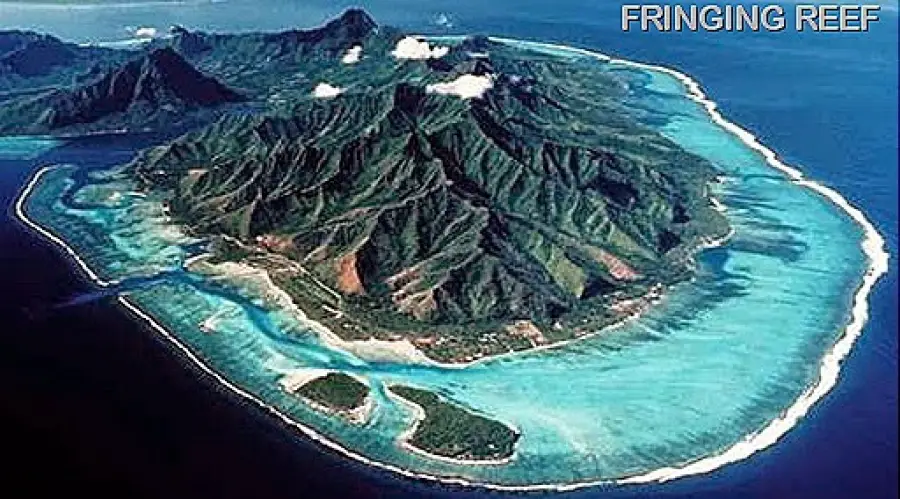In the previous post we learned about the beautiful world of coral reefs. Time to move on to their types. Basically there are 3 types of coral reef structures :-
🔵Fringing Reefs 🔵Barrier Reefs 🔵Atolls .
As reefs mature, they can develop from fringing reefs to barrier reefs to atolls.
🔵Fringing Reefs ► They are the most common type of reefs. They are located very close to land, and often form a shallow lagoon between the beach and the main body of the reef.They are often relatively young reefs and tend to be best developed on stable or rising coasts. Fringing reefs are most common in Caribbean sea and Red sea. According to Darwin, Fringing reefs are the first kind of reefs to form around a landmass in a long-term reef growth process. In India, it is seen in the Gulf of Munnar, Palk Bay, and in the western part of Andaman and Nicobar islands. In the west coast of India fringing reefs are seen in the Malvan coast and in the Gulf of Kutch including Pirotan island.
🔵Fringing Reefs 🔵Barrier Reefs 🔵Atolls .
As reefs mature, they can develop from fringing reefs to barrier reefs to atolls.
🔵Fringing Reefs ► They are the most common type of reefs. They are located very close to land, and often form a shallow lagoon between the beach and the main body of the reef.They are often relatively young reefs and tend to be best developed on stable or rising coasts. Fringing reefs are most common in Caribbean sea and Red sea. According to Darwin, Fringing reefs are the first kind of reefs to form around a landmass in a long-term reef growth process. In India, it is seen in the Gulf of Munnar, Palk Bay, and in the western part of Andaman and Nicobar islands. In the west coast of India fringing reefs are seen in the Malvan coast and in the Gulf of Kutch including Pirotan island.
🔵Barrier Reefs ► The largest coral reefs off the coastal platforms but parallel to them are called barrier reefs. These are offshore reefs that are separated from the land by an expanse of water, such as a lagoon(lagoon=pond/lake.A lagoon is a body of water separated from larger bodies of water by a natural barrier.These natural barriers can be sandbars, barrier reefs, coral reefs etc.etc). Barrier reefs tend to be much farther away from shore than fringing reefs. The lagoon separates the reef from the shore.This lagoon is suitable for navigation.The barrier reefs have narrow gaps at several places to allow the water from the enclosed lagoon to return to the open ocean. Such gaps are very useful for shipping and provide the only entrances for ships to enter or leave the lagoon. The barrier reef protects the lagoon from the harsh winds and waves of the open ocean.At their shallowest point, they can reach the water’s surface forming a “barrier” to navigation. Barrier reefs are the largest, most extensive, highest and widest reefs of all types of coral reefs. The best known barrier reef is the Great Barrier Reef off the coast of Queensland, Australia.
🔵Atolls ► Atolls are similar to barrier reefs except that they are circular in shape, enclosing a shallow lagoon without any land in the center.They are found mostly in oceanic mid-plate settings, where they rest on the peaks of submarine volcanic edifices called seamounts. Atolls are the product of the growth of tropical marine organisms, and so these islands are only found in warm tropical waters. They are often hidden by ocean waves. Thousands of ships have been stranded and wrecked on hidden atolls. Atolls are sparsely populated, low-lying islands whose white, sandy beaches and placid lagoons are ideally suited to the tourism industry.They, along with sandbars, are among islands with the lowest elevation. They are constantly, naturally at risk from erosion due to wind and waves. They are also at risk from sea level rise.Island nations such as Maldives and Kiribati are fortifying their atolls by dredging the seafloor. Coral atolls are also an important place where dolomitization of calcite occurs(Dolomitization= process by which limestone is altered into dolomite) . Most of the world’s great atolls are located in the Pacific Ocean, especially in the islands of Tuamotu, Caroline, Marshall, and the Coral Sea. The Great Chagos Bank in the Indian Ocean is the largest atoll in the world. Lakshadweep islands are an example of Indian atoll.




Comments
Post a Comment